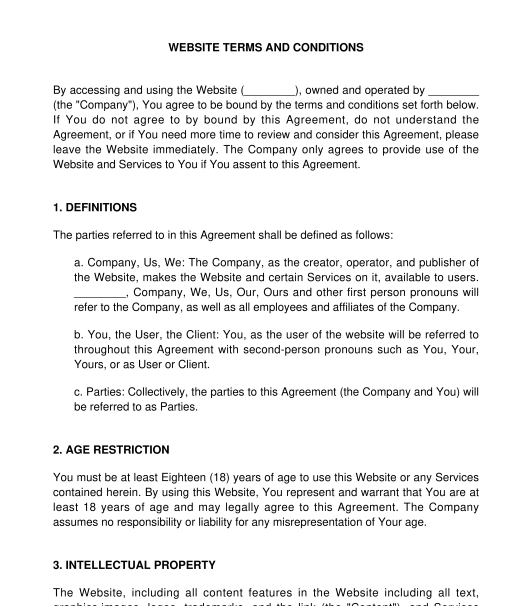 10/05/2025
10/05/2025

Answer a few questions and your document is created automatically.

Your document is ready! You will receive it in Word and PDF formats. You will be able to modify it.

 10/05/2025
10/05/2025
 Word and PDF
Word and PDF
 8 to 12 pages
8 to 12 pages
The Terms and Conditions for a website inform its users how to use the site properly, as well as the obligations and responsibilities of each party. If the user does not agree with the Terms and Conditions then said user may choose not to use the website.
Most websites, especially commercial websites, have a portion of the site devoted to the Terms and Conditions because it lets the site user know what is expected of them. It outlines what will happen in a variety of different possible situations including what happens if a user breaks the rules and must have their account terminated. Examples of these rules are age restrictions, user account creation and management, user interaction with the use of submission of media files, and rules concerning marketing, advertising, and sales.
While it is encouraged that both documents are used by the website and posted thereon, Terms and Conditions are different from a Privacy Policy. If the document requires the terms and conditions concerning the privacy rights of its users, a Privacy Policy for a Website should be used. On the other hand, if the document requires the terms and conditions concerning the general usage of the website, then Terms and Conditions for a Website should be used.
Terms and Conditions are not strictly required for live websites, but having a set of Terms and Conditions allows the owner to determine the rules for its users. Specifically, the Terms and Conditions should try to give the user information about what happens in almost any situation of their interaction with the website.
Further, the Terms and Conditions are necessary to set up the expectations for each of the parties to ensure that the website runs smoothly for both of them.
The parties in this document are the owner of the website and the site user. While it should be agreed upon by both parties, it usually cannot be changed by the user so that if the user uses the website, they agree to accept the Terms and Conditions of the website. However, if they don't agree to the Terms and Conditions, then they should not use the website.
After completing all the information required for the Terms and Conditions for a Website, the owner of the website should review the same.
Once the document is complete and reviewed, it should be published on the website in order for the users of the website to have access to it. It should be posted on its own separate page on a website which is ideally linked and can be accessed from the home page under the phrase "Terms and Conditions".
It is the choice of the website owner if he wants any of the following:
No costs or fees need to be paid for the Terms and Conditions for a Website, as it only requires postage of the same to a web page in the Website itself.
The Terms and Conditions for a Website contain the following information:
Although there is no one set of laws or regulations outlining what must be contained in the Terms and Conditions for a website, several laws may affect what may/should be included such as the Consumer Act of the Philippines (Republic Act No. 7394) and the Electronic Commerce Act of 2000 (Republic Act No. 8792) when the website also offers goods and services for sale. However, this may also be found in another part of the website.
A website is also broadly governed by the Civil Code of the Philippines and other Philippine laws.
You fill out a form. The document is created before your eyes as you respond to the questions.
At the end, you receive it in Word and PDF formats. You can modify it and reuse it.
Terms and Conditions for a Website - sample template
Country: Philippines